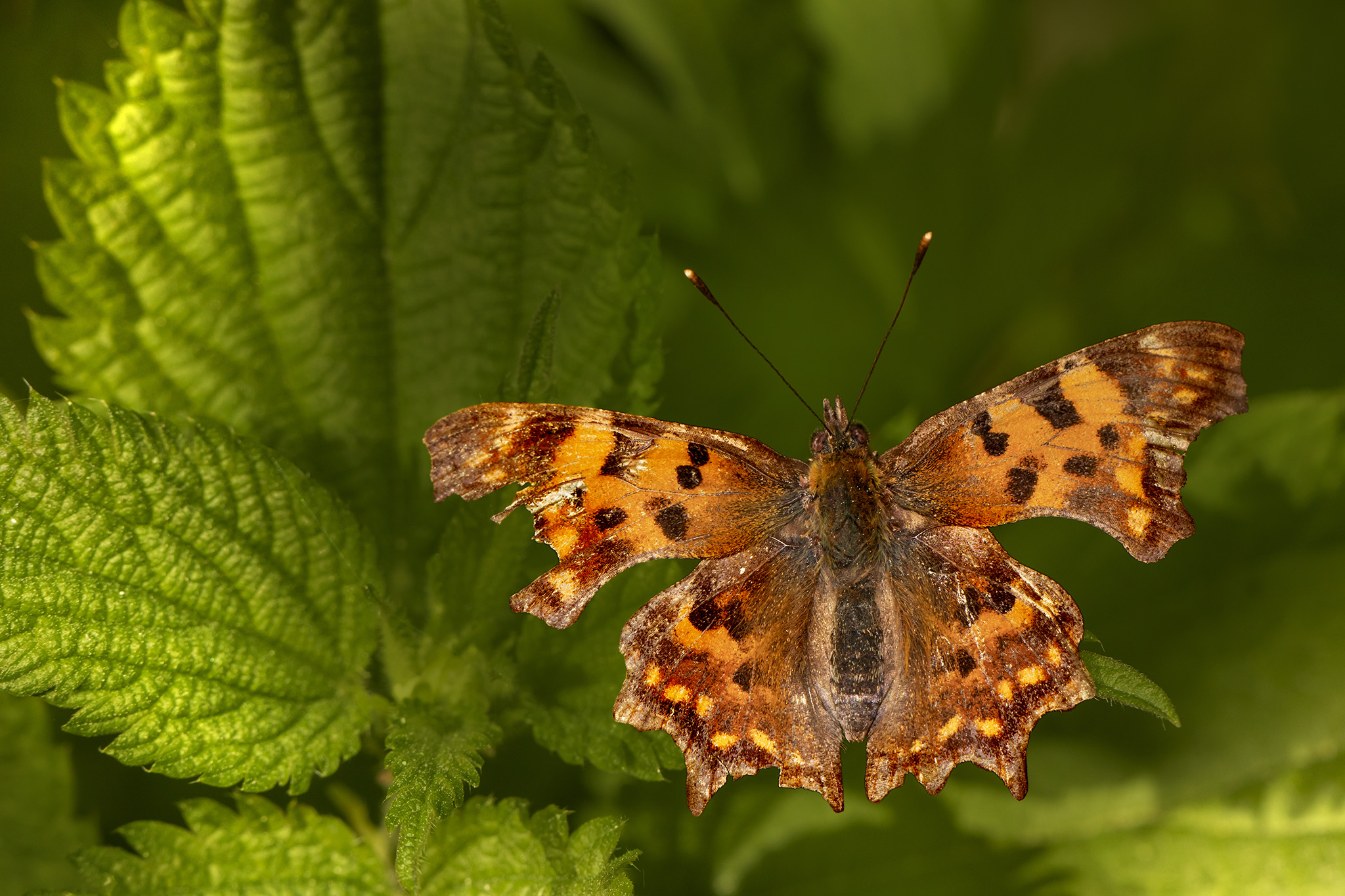The Comma (Polygonia c-album) is a distinctive butterfly belonging to the family Nymphalidae. It is easily recognized by the ragged edges of its wings and the small white “comma” mark on the underside of its hindwings, which gives the species its name. Found primarily in Europe and parts of Asia, the Comma is well-adapted to various habitats, including woodland edges, gardens, and hedgerows.
Physical Description:
- Wingspan: The wingspan of the Comma butterfly ranges between 50 and 64 mm.
- Upper side: The upper side of the wings is orange with dark brown or black spots, resembling other species in the Nymphalidae family. The deeply notched, scalloped edges of the wings give them a tattered or torn appearance, which is thought to provide camouflage among dead leaves.
- Underside: The underside of the wings is mottled brown, resembling a dried leaf. The key identifying feature is the small, white, comma-shaped mark on the hindwing. This cryptic coloration helps the butterfly blend into its surroundings when resting, especially during hibernation.
Behavior:
- Flight: The Comma has a characteristic strong, gliding flight, often interspersed with rapid wing beats. It can be seen basking with its wings spread out on sunny days, especially in warm, sheltered areas.
- Feeding: Adult Comma butterflies feed on nectar from a wide range of flowers, including buddleia, thistles, and brambles. In the autumn, they also feed on fallen fruit, such as rotting apples and pears, which provide essential nutrients before they enter hibernation.
- Hibernation: The Comma is one of the butterfly species that hibernate as adults. They seek shelter in tree crevices, logs, or even man-made structures, emerging in early spring to resume feeding and breeding.
Life Cycle:
- Eggs: Females lay their eggs singly on the leaves of host plants. The eggs are small, greenish, and shaped like tiny barrels.
- Caterpillars (Larvae): The caterpillars are blackish with white markings and spiny protrusions along their bodies. They resemble bird droppings, providing them with excellent camouflage. The larvae primarily feed on the leaves of nettles (Urtica dioica), hops (Humulus lupulus), willows, and elm trees.
- Pupation: The chrysalis is brown and also has a spiky appearance, further aiding in camouflage by resembling a withered leaf. The pupal stage lasts for about two weeks before the adult butterfly emerges.
- Generations: There are typically two generations per year. The first generation emerges in the early summer, while the second generation appears in late summer or early autumn, with some individuals hibernating through the winter.
Habitat:
The Comma butterfly prefers habitats with a mix of sunny open areas and sheltered spots for resting and hibernating. Typical habitats include:
- Woodland edges and clearings
- Hedgerows and field margins
- Gardens and parks
- Scrubby grasslands
It thrives in areas where nettles, one of its primary larval food plants, are abundant.
Distribution:
The Comma is widely distributed across Europe, from the British Isles to Scandinavia, and extends into parts of Asia, including China and Japan. It is a resident species in much of its range, although populations in northern areas may migrate southward in colder years.
Conservation Status:
The Comma is generally a widespread and common species in Europe, and its populations have shown signs of recovery in recent decades, possibly due to changes in agricultural practices that have allowed nettles and other food plants to thrive. It is listed as Least Concern on the IUCN Red List, and no significant threats are currently facing the species, although local habitat loss could affect populations.
Interesting Facts:
- Camouflage: The Comma’s jagged wing edges and leaf-like pattern on its underside provide excellent camouflage, especially when it rests with its wings closed. It can remain virtually invisible to predators while resting on dead leaves or bark.
- Hibernation Adaptability: Unlike many butterflies that spend the winter as larvae or pupae, the Comma hibernates as an adult. This strategy allows it to take advantage of early warm weather in the spring, making it one of the first butterflies to be seen in the year.
- Historical Decline and Recovery: In the 19th and early 20th centuries, the Comma’s populations in the UK saw a sharp decline, possibly due to changes in land use and agricultural practices. However, it has made a remarkable comeback and is now commonly seen across much of its former range.
Ecological Role:
As both a pollinator and a prey species, the Comma butterfly plays an important role in its ecosystem. As adults, they help pollinate various flowers, while their caterpillars serve as food for birds and other insectivorous animals. Additionally, their reliance on nettles for larval development emphasizes the ecological importance of maintaining wild, uncultivated areas.
Conclusion:
The Comma (Polygonia c-album) is a fascinating butterfly known for its unique appearance and impressive adaptability. Its jagged wings and cryptic coloration make it one of the most recognizable butterflies in Europe and parts of Asia. Whether basking in the sun or blending in among autumn leaves, the Comma is a resilient and important part of its natural environment. Its recovery in some regions demonstrates the benefits of preserving wild areas and supporting native plants like nettles that serve as critical resources for wildlife.
Views: 1459
